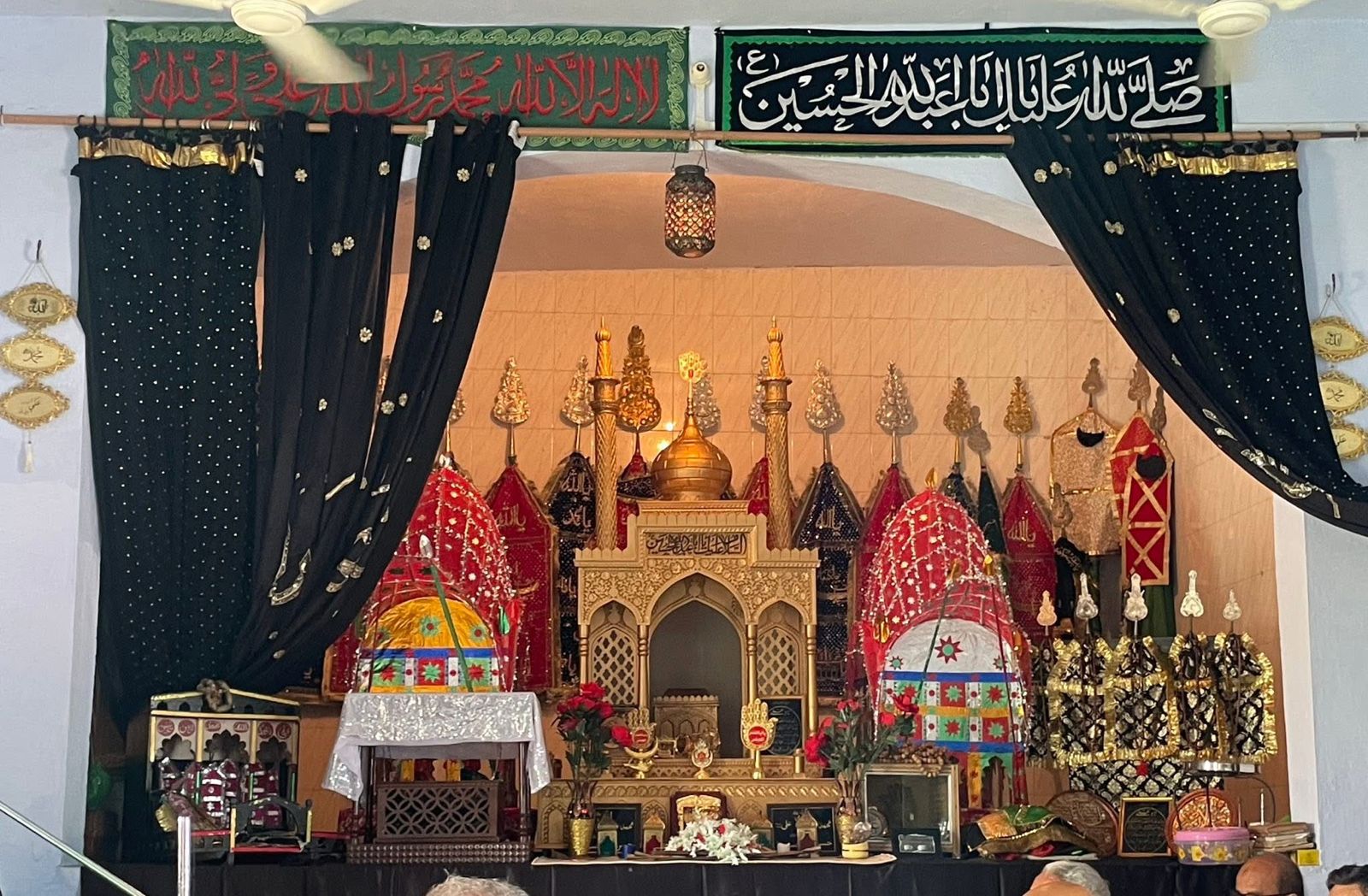Commemoration, Not Celebration
As the crescent moon heralds Muharram, the first month of the Islamic lunar calendar, a question arises: Is Muharram a festival to celebrate or a solemn occasion to commemorate? Far from a festive event, Muharram is a time of profound reflection, particularly for Shi’ite Muslims, who mourn the martyrdom of Imam Husain ibn Ali, the grandson of Prophet Muhammad, on the 10th day, known as Ashura. Yet, in the Indian subcontinent, Muharram transcends religious boundaries, uniting communities in a shared reverence for Husain’s stand against tyranny, celebrated by some as a triumph of good over evil.
This article delves into the historical, religious, and social significance of Muharram, with a focus on its unique resonance in India.
“If you want to understand Islam then first understand Kar’bala.”
~Muhammad Ali (The legendary boxer)
The Battle of Kar’bala: A Clash of Ideologies
In 680 CE, the desert of Kar’bala, now in Iraq, witnessed a tragic yet pivotal event. Imam Husain, representing the Prophet’s household and the values of justice and submission to God, faced Yazid ibn Muawiya, an Umayyad caliph whose rule embodied corruption and oppression. Yazid, having usurped the caliphate, demanded Husain’s allegiance to legitimize his authority. Husain’s refusal led to a brutal confrontation. With only 72 companions, including his family, Husain faced thousands of Yazid’s troops led by Umar ibn Sa’ad. Denied water and food, Husain, his sons—including six-month-old Ali Asghar—and his followers were martyred.
This was no mere political skirmish but a clash of ideologies: Husain’s message of peace and dignity against Yazid’s tyranny. His sacrifice, likened to the Quranic “zibh un azīm” (supreme sacrifice), echoed Prophet Abraham’s offering. The Urdu couplet captures its essence: “Qatl-i Husain asl mein marg-i Yazid hai, Islam zinda hota hai bas Kar’bala ke baad” (The massacre of Husain is the death of Yazid; Islam is revived through Kar’bala). Husain’s stand remains a timeless call to resist oppression, inspiring movements from the Iranian Revolution to Lebanon’s liberation.
Religious Significance: A Sacred Month
Muharram is one of Islam’s four sanctified months, where bloodshed is forbidden, its name derived from roots meaning “sacred” and “forbidden.” The first ten days, called Ashra, are especially significant for Shi’ite Muslims, who mourn Husain’s martyrdom through rituals like majlis (gatherings), marsiyas (elegies), and matam (chest-beating to share Husain’s pain). Ashura also marks other divine events: Prophet Adam’s repentance, Noah’s salvation, and Moses’ deliverance from Pharaoh, making it a day of universal spiritual weight.
For Shi’ites, Muharram is a solemn remembrance, not a celebration. Greetings like “Happy Muharram” are inappropriate, akin to wishing “Happy Good Friday” for Christians. Yet, for some Sunni Muslims and non-Muslims, Ashura is a day to fast and honour Husain’s moral victory, drawing parallels with narratives like the Mahabharata’s triumph of good over evil.
Imam Husain’s Strategy: A Revolution Planned
Husain’s actions were deliberate, as scholars like Syed Jafar Raza Bilgrami note. He aimed to rebuild a system where reason governs greed and violence. His strategy included:
1 Choice of Location: Husain chose Iraq over Mecca to avoid desecrating the holy city and to expose Yazid’s tyranny publicly. Kar’bala ensured his mission’s visibility.
2 Choice of Companions: His diverse group—ranging from infants to the elderly, including a Christian couple—underscored a universal fight, not a tribal feud.
3 Preserving the Legacy: By including women like his sister Zainab, Husain ensured his message endured. Zainab’s fearless speeches in Yazid’s court and beyond exposed his falsehood, igniting a revolution.
Historians and thinkers have lauded Husain’s sacrifice. Charles Dickens noted that Husain’s family’s presence negated worldly motives, while Thomas Carlyle marvelled at his victory despite numerical odds. Edward Gibbon wrote that Kar’bala’stragedy stirs even the “coldest reader,” and Sir Mohammad Iqbal called Husain the foundation of Islamic monotheism.
Muharram in India: A Cultural Tapestry
In the Indian subcontinent, Muharram is a vibrant blend of mourning and cultural unity. Historical ties with India date back to the Prophet’s era, with Indian merchants trading in Arabia and introducing items like achār. Husain reportedly expressed a desire to seek refuge in Hindustan when cornered by Yazid’s forces. Post-Kar’bala, Indian communities, including the Zutts (likely Jats) and Brahmins, resisted Yazid’s army to protect Husain’s family, cementing an enduring bond.
The Hussaini Brahmins, particularly from Punjab, Haryana, and Kashmir, are a striking example. Claiming descent from ancestors who fought for Husain, they bear sword marks on their necks as a divine reminder. In Delhi and Pune, they join Muharram processions, carrying tazias and performing matam, blending Hindu and Muslim traditions. As a Hindustani saying goes: “Wah Datt Sultan, Hindu ka dharm, Musalman ka iman, adha Hindu adha Musalman” (Hail Datt Sultan, Hindu by faith, Muslim by conviction, half Hindu, half Muslim).
Indian Muharram rituals, from tazias resembling Jagannath Rathas to marsiyas influenced by local poetry, reflect deep Indianization. Hindu rulers like Raja Dahir sheltered Husain’s descendants, and Maratha kingdoms in Gwalior and Baroda still honour Muharram with processions. Tribal communities like the Gonds revere tazias, making Muharram a cultural ambassador that fosters a shared Indian identity.
Social Impact: Bridging Divides
Muharram’s social significance in India lies in its ability to unite diverse communities. In a nation often divided by religion, the participation of Hindus, Sikhs, and others in Muharram processions—especially by Hussaini Brahmins—challenges communal stereotypes. Their processions mirror Muslim ones, symbolizing solidarity. Muharram’s message of resisting tyranny resonates in India’s fight against social injustices, encouraging collective action for justice and equality.
Mourning and Celebration: A Harmonious Duality
For Shi’ite Muslims, Muharram is a time of grief, with rituals reflecting Husain’s suffering. For others, particularly non-Muslims, Ashura celebrates his moral triumph, akin to universal narratives of good prevailing over evil. In India, this duality harmonizes, as communities mourn the tragedy while celebrating Husain’s enduring legacy of courage and justice.
A Call for Unity
Muharram is a profound reminder of Imam Husain’s sacrifice, a call to resist oppression and uphold dignity. In India, it weaves a tapestry of cultural unity, where Muslims and non-Muslims honour a shared heritage.
In the words of the poet Wamiq Jaunpuri
“Falak pe chand Muharram ka dekh kar Wamiq,
Khushi ye hai ki shaheedon ke gham mein royengey”!
(Seeing the moon of Muharram in the sky, Wamiq,
The happiness is that we will cry for the martyrs).
~Hasnain Naqvi is a former member of the history faculty at St. Xavier’s College, Mumbai






